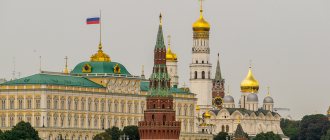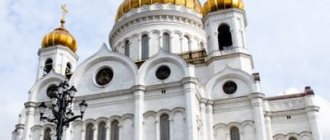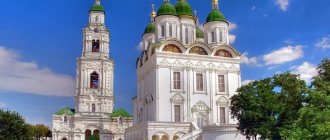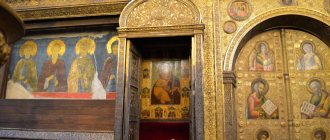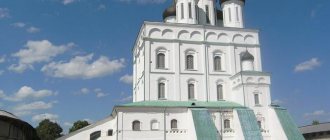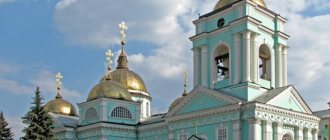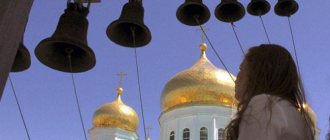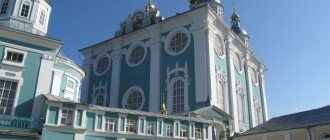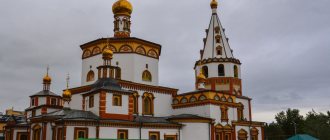The Tula Cathedral of the Assumption of the Blessed Virgin Mary is an Orthodox church, part of the Tula and Efremov diocese of the Russian Orthodox Church. Until 1917 it was a monastery church. The Assumption Cathedral in Tula has an interesting history, dating back to the 17th century.
Story
Initially, a small wooden church, the Arkhangelskaya Church, was erected in the Tula Kremlin, which appeared in 1626. A stone temple in its place was built in the 70-80s of the same century, but its “first version” quickly fell into disrepair. In May 1762, a new temple was founded. The construction was blessed by Bishop Porfiry of Kolomna and Kashira.
The construction was sponsored by Sofron Sidnev, Andrei Volodimirov and merchant Lukyan Kopteltsev (after his death - burgomaster Timofey Chechulin). The construction of the parish was completed two years later, and already in 1766 it was consecrated. However, the temple was not initially heated, so it served as a “summer” church and opened its doors only from Easter to Intercession.
Soviet period in the history of the cathedral
In 1930, the Soviet government closed the temple. They wanted to organize a museum of atheism there, but it never came to fruition. The icons and vestments were partially given to the St. Nicholas Church.
In 1945, the temple became a monument of All-Union significance. After 15 years, the building was placed under state protection, but this did not prevent the establishment of a warehouse for manufactured goods in the Assumption Cathedral the following year. The restoration took place as part of the restoration of the Tula Kremlin and began in 1965; The iconostasis was restored from 1975 until 1986.
Fire damaged the murals at different times. In 1988, Moscow artists led by V.L. Lagutin undertook to restore it.
Renaissance
The revival of the temple began in 1991. The temple was transferred to the Tula diocesan administration. It was planned to share the cathedral with the local history museum, which was responsible for the architectural structure as a whole. But due to lack of funding, restoration work gradually faded away and resumed only in 2013, again as part of the overall restoration of the Kremlin. Before this, in 2005, the cathedral’s illumination was turned on for the first time.
The restored temple was solemnly opened in 2015, when the city celebrated its birthday.
Church location
The temple is located in the very center of the city on Lenin Square next to the city administration building and very close to the Tula Kremlin.
A historical curiosity: the leader of the world proletariat V.I. Lenin, whose monument is installed on the square, looks directly at the Assumption Cathedral, which the Bolsheviks were never able to blow up.
Next to the temple is the Tula Kremlin, a complex of buildings that includes:
- Assumption Church of the Tula Kremlin;
- Epiphany Cathedral of the Tula Kremlin;
- shopping arcades.
How to get there
Address: 300600, Tula, st. Mendeleevskaya, 13 (letter “L”).
Public transport stop - “Lenin Square”:
- bus No. 1, 11, 18, 25, 27a, 28, 28a, 117, 175;
- trolleybus No. 1, 2, 11;
- minibus No. 9, 17, 18k, 30, 33 34, 35, 37, 40k, 50, 51, 53, 58, 62, 114, 175, 280, 1117.
Architecture
Bright, elegant, rich in details and varied decor, the cathedral is the main attraction of the Tula Kremlin. The name of the architect who designed this man-made miracle remains, alas, unknown. However, history has preserved for us the names of the craftsmen involved in the construction: brickmakers Emelyan Tsybin and Onisiy Dobrynin, blacksmith Osip Zhurov and his assistants. The chapters became gold with the participation of the merchant from Tula Larion Sorokin.
The strong, stable, almost cubic mass of the temple suddenly rushes upward with light bulbous domes, of which it has five - according to the number of light drums “covered” by them. From the east, a low altar adjoins the building - a solution that refers to the city cathedrals of the 16th–17th centuries. With the volume, executed without frills, the abundant decoration of the temple comes into conflict - the influence of Russian Baroque. The shapes and materials of decorations on the walls are especially varied.
Two rows of windows provide the church with excellent lighting. All three entrances are framed by portals. The main entrance is decorated with a double-headed eagle - a symbol of Russian statehood.
painting
Yaroslavl painters from the heyday of their school showed all their art using the example of this temple. During the warm season in 1765–1766. they worked tirelessly as a team of 36 people under the leadership of Afanasy Andreevich Shustov.
The fine design of the walls, piers, and window slopes is monumental and adds solemnity to the appearance. The paintings are arranged in accordance with tiers, their subjects are traditional for Orthodox churches. The peculiarity of the painting here is the clear depiction of even minor details.
Iconostasis
Icons by unknown masters - hired artists L. Sorokin - and the Kaluga clergyman Andrei Filippov are arranged in seven tiers. Three more icons were painted by the gunsmith Grigory Belousov, a recognized icon painter from Tula. Initially, the iconostasis consisted of 66 icons, but 10 fewer have survived to this day.
Divine services
Since 2003, the dean of the churches of the city of Tula, Archpriest Sergei Rezukhin, has served as rector of the Holy Dormition parish.
Divine services are held daily, the church is open to believers from 8.00 to 20.00 on Saturday and Sunday - from 7.30 to 20.00.
Schedule of services on weekdays:
- morning Divine Liturgy - at 8.00;
- evening liturgy - at 17.00.
Schedule of services on holidays and weekends:
- early mass is celebrated at 7.30;
- late mass - at 10.00;
- evening service - at 17.00.
The patronal holiday is the day of the Dormition of the Blessed Virgin Mary, celebrated on August 28 (new style).
Photos
We have prepared several photographs of the cathedral.
Bell tower
The architecture of the Assumption Cathedral of the Tula Kremlin is very unique. The Assumption Cathedral previously did not have an internal heating system and therefore did not function during the winter period. The design of the Assumption Cathedral is impressive - the powerful geometrically regular forms of the building are topped with five voluminous gilded domes with forged massive crosses on them. The interior decoration of the cathedral is particularly splendid and amazingly rich, and its design style belongs to the Russian Baroque variation. The low altar in the east of the room is typical of simple city cathedrals of the 16th–17th centuries.
The paintings in the Assumption Cathedral were carried out by eminent masters from Yaroslavl, who were able to display the best trends of the Yaroslavl school, which was at its peak at that time. 36 Yaroslavl craftsmen worked for two summers in a row immediately after the construction of the temple until 1766. Afanasy Shustov became the main painter. The result of long work was a solemn and majestic painting, which amazes with close-ups and exquisite details.
The four-tier bell tower of the Assumption Cathedral was erected between 1772 and 1776. The Kremlin bell tower is still one of the central dominants in the architecture of the city. In the first version, the height of the bell tower to the cross was just over 70 meters. The bell tower housed 22 bells, above which a striking clock was located. The vintage clock was later replaced by a modern model with two hands.
In 1778, a warm church was built on the lower floor of the bell tower. In 1936, a fire started in the bell tower, which could not be extinguished. The bell tower was destroyed and dismantled in 1937.
In 1999, archaeological excavations were carried out on the territory of the bell tower. Restoration of the building itself began in 2012. The bells were consecrated in 2013, and the spire was installed in 2014. The height of the updated bell tower is now 71 meters. The bell tower and cathedral were inaugurated in 2015.
History[edit]
The time of construction of the first, main temple of the Assumption Convent has not been precisely established. From documents of the 18th century it is clear that it was a stone two-story building. On the upper floor there was a throne in the name of the Dormition of the Blessed Virgin Mary and a chapel in the name of St. Alexander of Svirsky, on the lower floor there was a throne in honor of the Burning Bush icon of the Mother of God and a chapel of St. Nicholas the Wonderworker. Over time, the building became dilapidated and began to sink into the ground; in the spring and on rainy days, the first floor was flooded with water. The church was dismantled and in 1791-1792 a new one was built - stone, one-story - with money allocated from the treasury by Catherine II, under the care of the Tula civil governor Andrei Ivanovich Lopukhin. The main altar was consecrated in the name of the Dormition of the Blessed Virgin Mary, the southern chapel was dedicated to the Burning Bush icon, and the northern chapel to Alexander Svirsky. In 1857, the temple, which had already fallen into a rather dilapidated state, was expanded, after which its decay only accelerated.
In 1899, they began to dismantle this church, and by 1902, a new two-story building was erected in its place. The lower warm church with one altar in the name of Equal-to-the-Apostles Mary Magdalene and the Great Martyr Panteleimon the Healer was consecrated on October 24, 1902. The upper one, with the main altar of the Assumption - June 28, 1904, and the aisles of the upper church - in the name of the Burning Bush icon and in the name of Alexander Svirsky - July 11, 1910 and July 3, 1911.
The Assumption Church was built in the pseudo-Russian style. Her original, unrealized project has been preserved, which is close to the built temple, but provides for slightly different decorative and plastic elements. During the construction process, Gothic decorative elements—lancet window frames on drums—were abandoned. They also did not make a horizontal three-part division of the facades with windows - in the case of such a division, the building would appear to be three-story. The walls of the upper church were painted in 1909. Perhaps the artists were co-workers of Viktor Vasnetsov, since the paintings of the temple are exact copies of his works in the Kiev Vladimir Cathedral. On the wall of the upper temple there is an inscription: “In
In 1909, through the diligence of the abbess, Abbess Magdalene, and with the help of benefactors, this cathedral church was decorated with wall paintings and ornaments
.
The walls of the cathedral are made of dark red brick. The black domes are topped with crosses and crescents. Abbess Agnia, revered in Tula, who was involved in the construction of the temple, was buried in the cathedral.
When the Bolsheviks came to power, the monastery was abolished and the cathedral was closed. In the 1930s they tried to blow it up, but the cathedral turned out to be very strong and survived. Then the domes were knocked off and a branch of the state archive was placed. At the end of the 1980s, the building was reconstructed. The domes were reinstalled and the base of the cathedral was strengthened.
